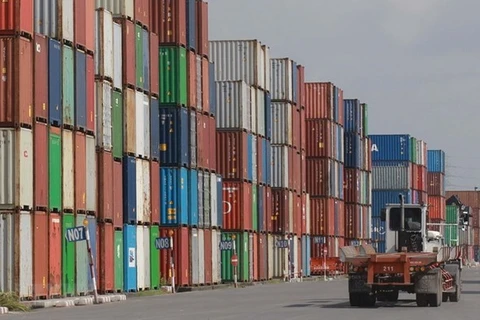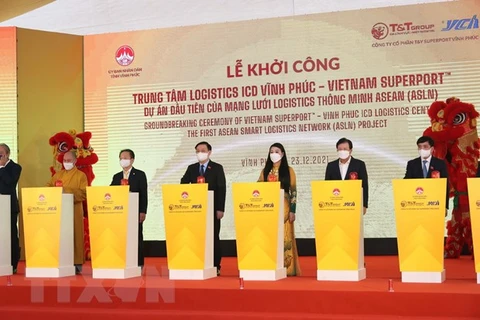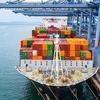 Vietnam logistics industry has many opportunities for growth if it improves competitiveness. (Photo: VNA)
Vietnam logistics industry has many opportunities for growth if it improves competitiveness. (Photo: VNA) According to the Ministry of Industry and Trade (MoIT), import and export turnover of goods will continue to grow this year, creating demand for logistics services. By the end of 2021, Vietnam's total import and export turnover is expected to reach a record level of more than 660 billion USD.
More than 4,000 logistics enterprises are operating international logistics services in Vietnam where their operation has been increasingly improved thanks to increasing digital transformation applications and better business processes, especially ones providing services to European, American and Chinese markets.
According to the MoIT’s Vietnam Logistics Report 2021, in the first nine months of 2021, the number of newly registered transport and warehousing enterprises increased by 4.61 percent, and capital increased by 43 percent over the same period in 2020.
MoIT data showed that in 2021 many logistics enterprises grew in revenue and profit, most with double-digit growth, adding that the volume of goods transported by road and waterways in 10 months of 2021 significantly improved compared to the same term of 2020.
The total tonnage of ships increased sharply by 22 percent over the same period. The economic situation in the main export markets of Vietnam also recovered.
The GDP of major consumer markets in the world such as the US, EU, Japan, and China is forecast to continue to grow in 2022 and 2023.
Over the years, Vietnam’s logistics industry has made remarkable progress. Vietnam's logistics efficiency index is currently ranked 39 out of 160, up 25 places compared to 2016, which is third among ASEAN countries. However, logistics costs in Vietnam were still much higher than throughout the world.
According to World Bank (WB) 2020 data, logistics costs in the country were about 20.9-25 percent of GDP. Meanwhile, the cost in Thailand was 19 percent, Malaysia 13 percent, Singapore 8 percent, and the US 7.7 percent.
High logistics costs push up the cost of import and export goods of 2020 data, which loses its competitive advantage compared to other countries in Asia such as China, Thailand, the Philippines and Indonesia.
With pressure in the fierce competition of international trade, the race in technology continues to create competitive advantages, save time, optimise costs, create flexibility and reduce risks.
A representative of the Vietnam Logistics Service Association (VLA) said about 95 percent of logistics firms were small and micro enterprises, and most of the revenue and market share belonged to foreign logistics enterprises.
The association said the proportion of newly established transport and warehousing enterprises compared to the total number of enterprises in the country was still modest and the capital scale of enterprises in the industry was still limited.
In the first nine months of 2021, there were 2,509 transport and warehousing enterprises that had to temporarily suspend operations, an increase of 14.1 percent over the same period in 2020. At the same time, 571 enterprises completed dissolution procedures, up 17.7 percent over the same period in 2020, the association said.
“Currently, Vietnamese logistics enterprises continue to face stiff competition with foreign logistics enterprises,” a VLA representative also said.
Ho Thi Thu Hoa, Director of the Vietnam Logistics Research and Development Institute, said that in order to improve the competitiveness of the economy and trade activities, Vietnamese logistics enterprises needed to focus on the provision of high value-added services such as third-party logistics services and fourth-party logistics services, international multimodal transport services, and cross-border logistics services.
Hoa said: “In order to have strong logistics enterprises, in addition to providing logistics services with the highest quality and standards, businesses need to make efforts in building a system that can flexibly adapt to market fluctuations.”
She said it was particularly necessary to promote the digital transformation process in logistics management through electronic port applications, automatic monitoring, application of cloud computing technology and artificial intelligence to support and care activities, and at the same time develop high-quality human resources./.
VNA






















